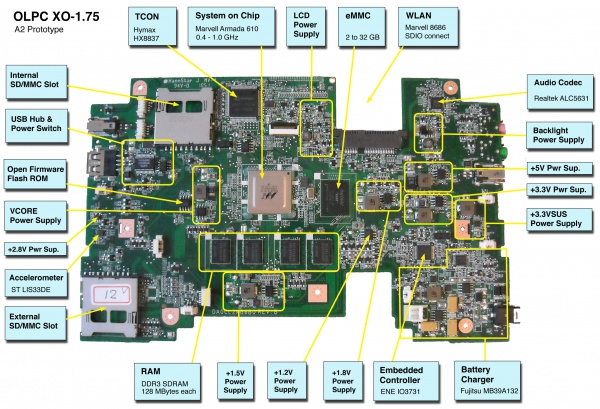XO 1.75 A3
XO-1.75 Laptop Alpha test model 3, also known as A3.
Description
The A3 are the third prototypes of the XO-1.75 built. The main change is to the power distribution circuitry, but they also use a mostly tested A2 silicon stepping of the Armada 610 SoC, which did wonders for yields. The number of boards obtained was thirty, and distribution was limited to hardware testing, OFW and Linux kernel driver development.
Identification
These were bare circuit boards, with no case or display, most developers obtain one pre-assembled into an earlier XO-1 or XO-1.5 laptop enclosure with all peripherals attached. They should be marked as "XO-1.75 A3" with a serial number handwritten in the battery compartment.
Photographs:
If you disassemble the laptop (instructions), you will see:
Software Support
- we used firmware releases starting with Q4A11,
- we stopped making firmware releases at Q4B10,
- no further firmware releases are expected,
- upgrading the EC using flash-ec requires Q4A14 or later,
- the Linux builds were at http://build.laptop.org/F13-arm/.
Restrictions
There is a list of recommended modifications (ECOs). There is also a list of changes proposed from A3 to B1.
Audio Input
Due to a wiring mistake, the microphone doesn't work properly unless the A3 motherboard is modified. (Trac ticket #10974). Most laptops have not been modified --- look for AUDIO on the tag.
Thermal
At this time, Quanta has reported two problem instances (failure to write eMMC) that they believe are linked to excessive temperature. Around OLPC, we have been using prototypes without heat spreaders (and with covers) without a problem for months. In any case, most laptops sent out with an A3 motherboard have a prototype heat spreader installed.
If you have any problems writing to the eMMC, please trac it!
USB Power
On some number of the A3 motherboards, the current limit on the USB output may be as low as 0.55A (2.75W), instead of the design goal of 1A (5W). We are working to fix this.
Power Supply
An XO-1.75 should operate with the original green power adapter (17W), but only if running EC firmware CL2_4.0.0.11 or later. The EC firmware shipped on the A3 laptops (CL2_4.0.0.10 or earlier) will draw 25W when charging a battery.
Failure to boot
One known problem with A3 motherboards is a failure to successfully boot when cold (ticket #10901). The symptoms are a white screen or OFW error messages such as "Data Abort" or "Software Interrupt" followed by a prompt. If you have a laptop that shows this, please report it immediately to wad.
WLAN card
XO-1.75 require the new, +1.8V tolerant, WLAN card. Do not place the WLAN card from an pre-production or early production XO-1.5 in an XO-1.75! It will release its smoke and stop working.
The WLAN card used for XO-1.5 production since Sept. 2010 is a +1.8V tolerant WLAN card. We have a supply of these at 222 for prototypes.
Selecting the internal SD
Only one of the internal SD slot and the eMMC may be used at any time. If an SD card is present in the internal slot when OFW boots, it will be used. Otherwise, the onboard eMMC device is selected.
Mechanical Problem with Touchscreen Connector
The touchscreen connector, CN22, is mounted on A3 motherboards. This connector interferes with proper mounting on the motherboard in unmodified laptops. In production (starting with B1 prototypes) this connector will not be mounted). It is easier to modify the mainframe of a laptop instead of removing the connector from the motherboard.
Gradual Turn-off of Display
The display gradually turns off on the A3 prototypes, due to improper power-off sequencing of the LCD power supplies. Trac ticket #10964. This is fixed when using EC firmware 4.0.1.00 or later and OFW Q4A15 or later.
RTC Amnesia
The RTC loses stored time across power cycles and Linux reboots (<trac>10999</trac>). There is an ECO which fixes this, applied to a small number of motherboards. In B-phase the RTC circuitry will be changed to fix this.
Documentation
Supporting documentation for these boards (all in PDF):
Please note that production boards will likely have different pin mappings and connector locations.
There are also the Tinderbox power measurements.
